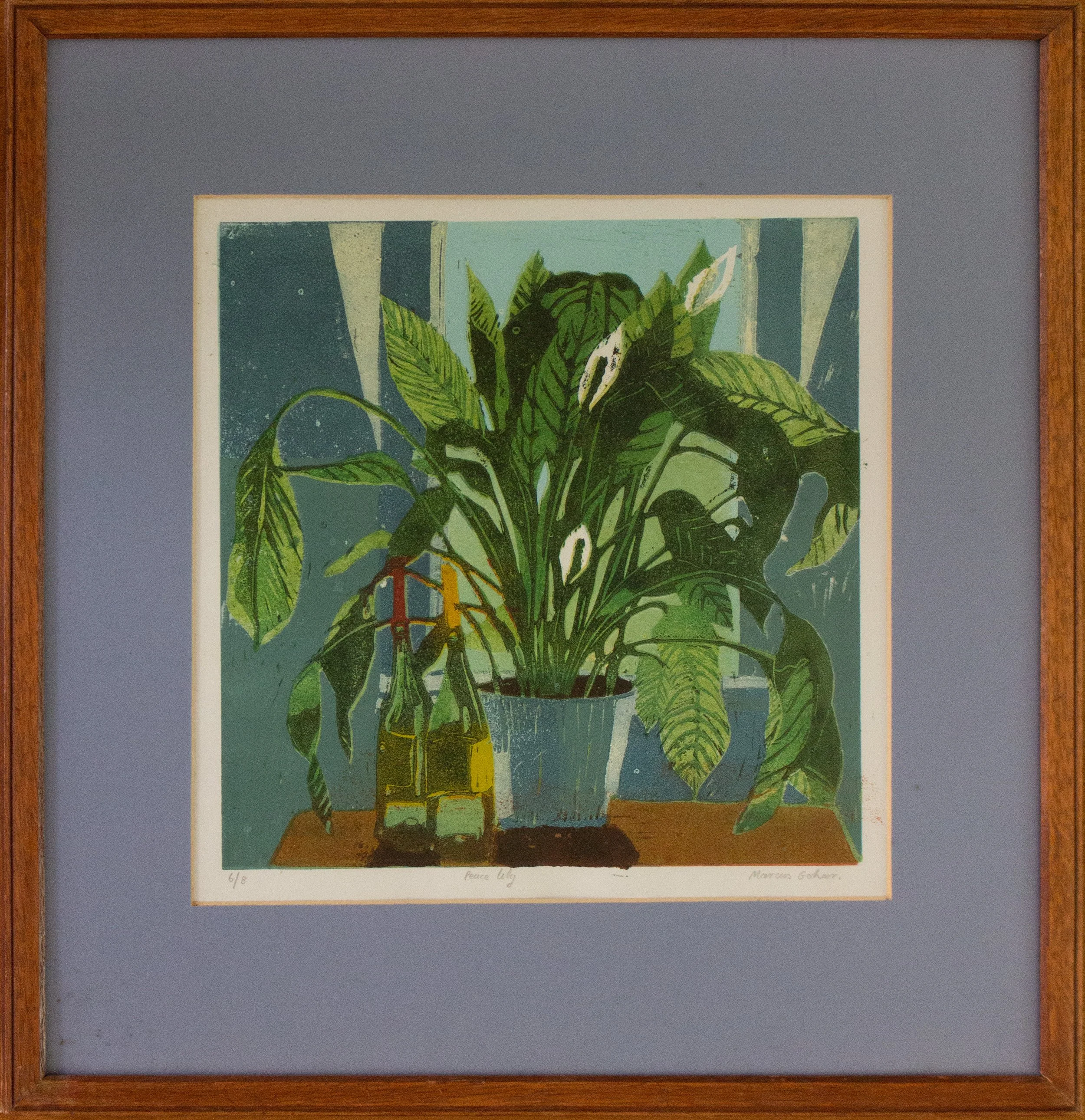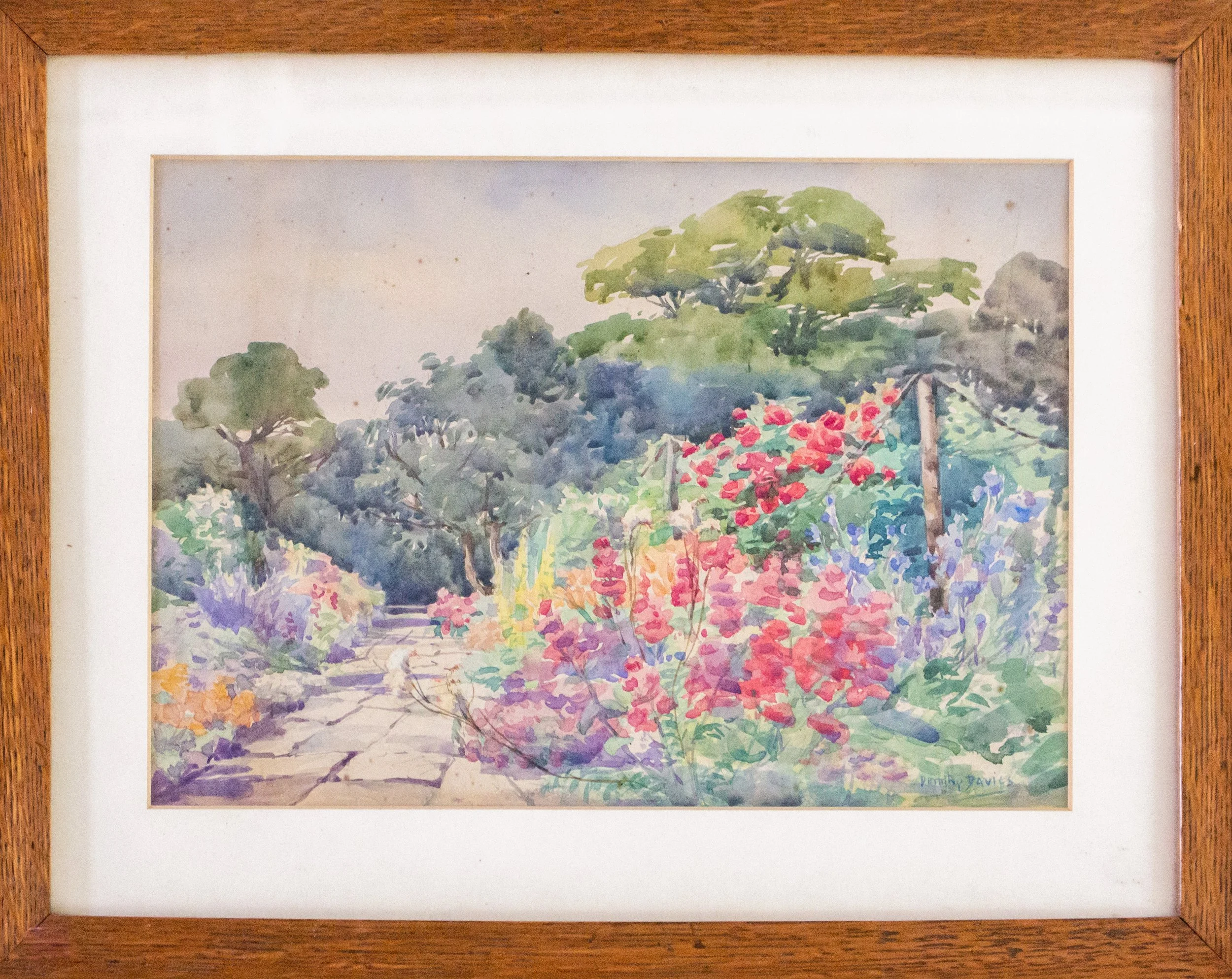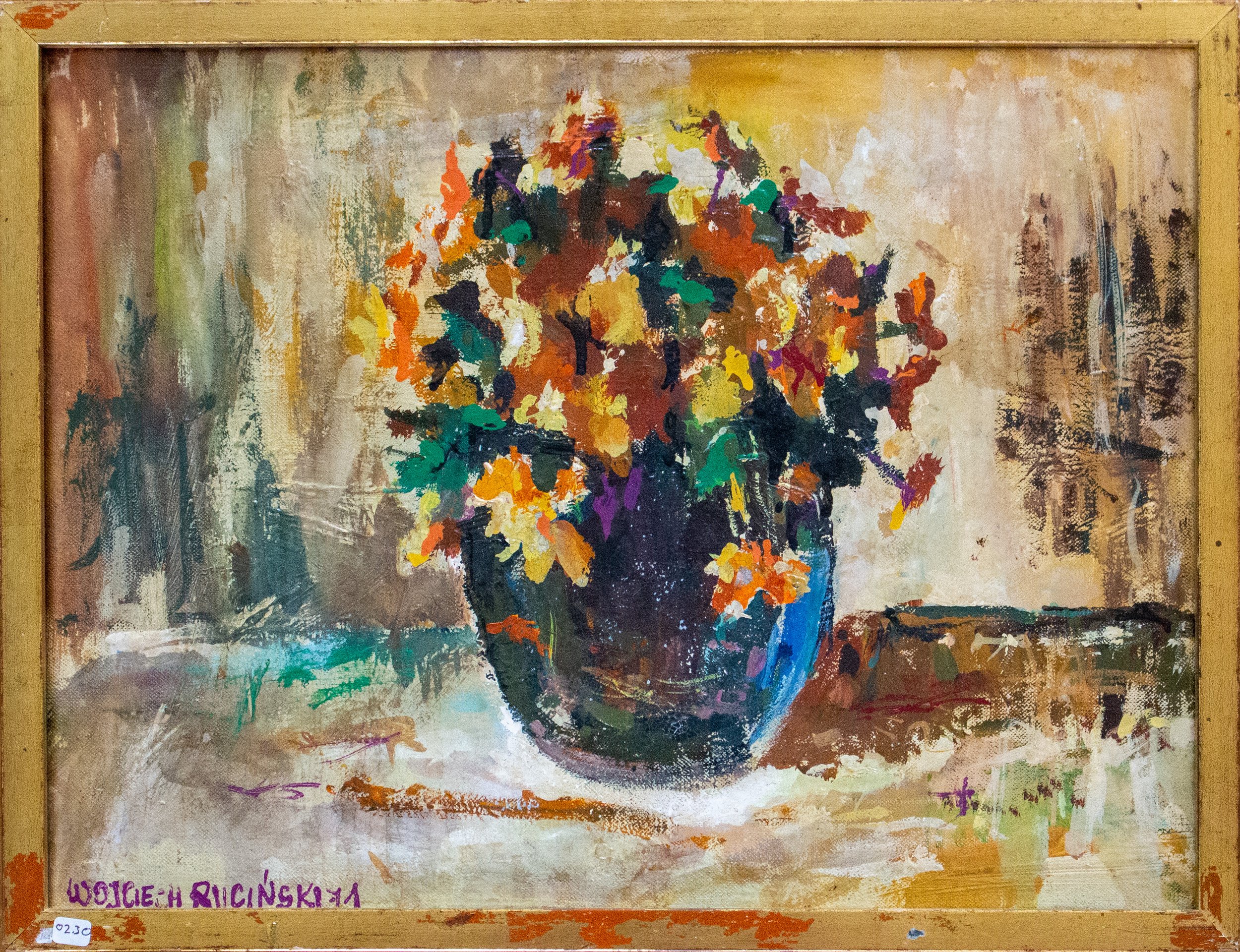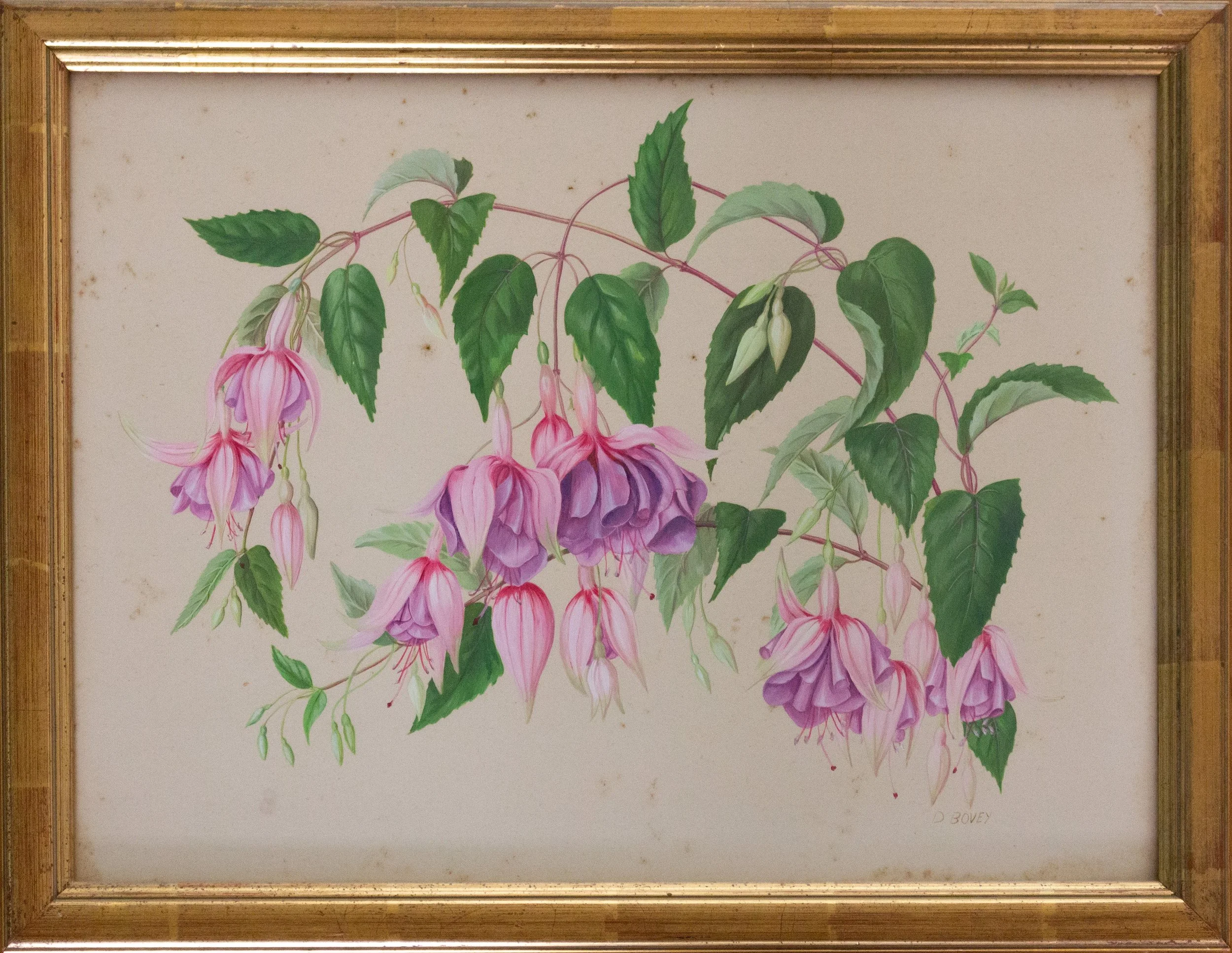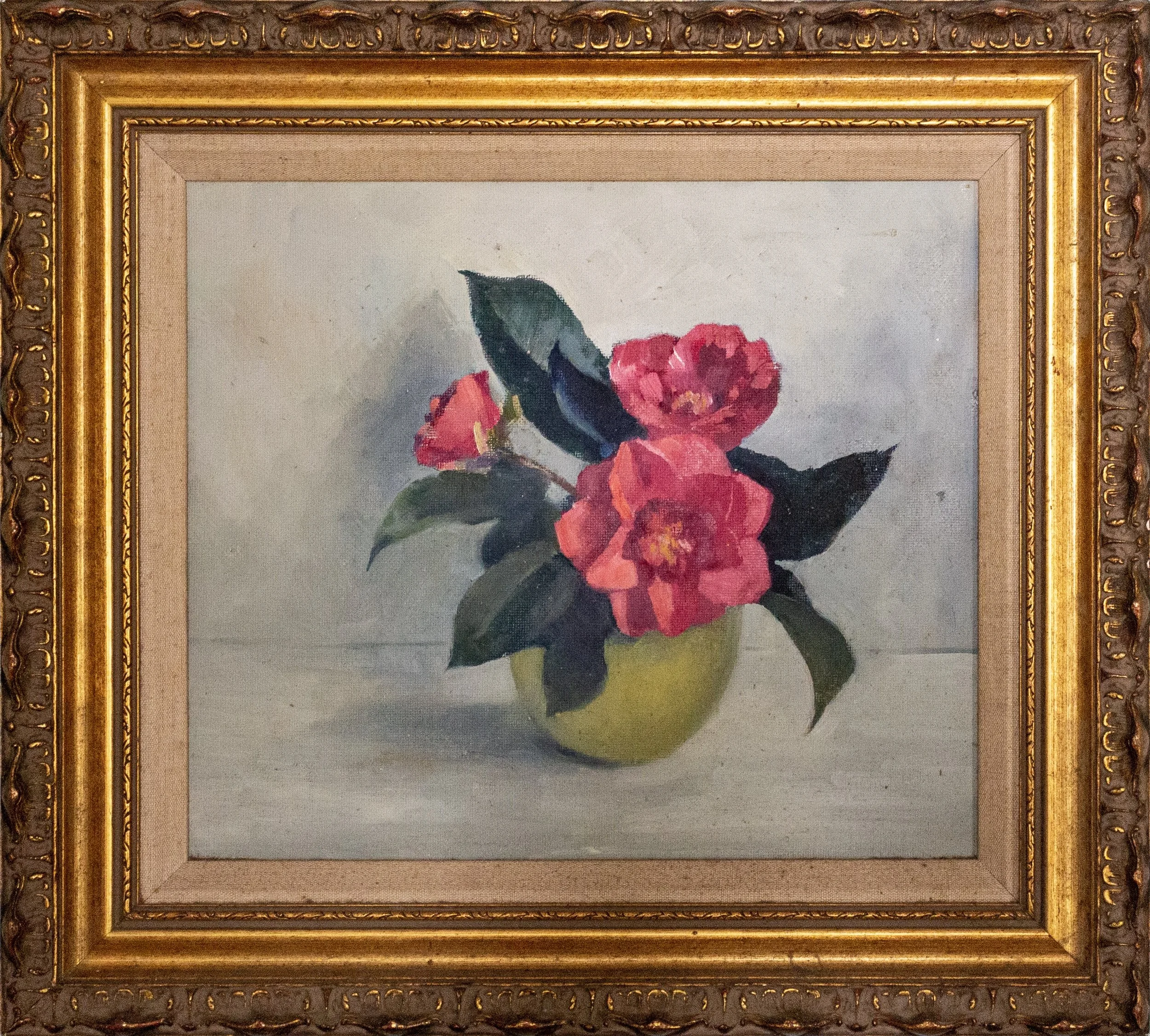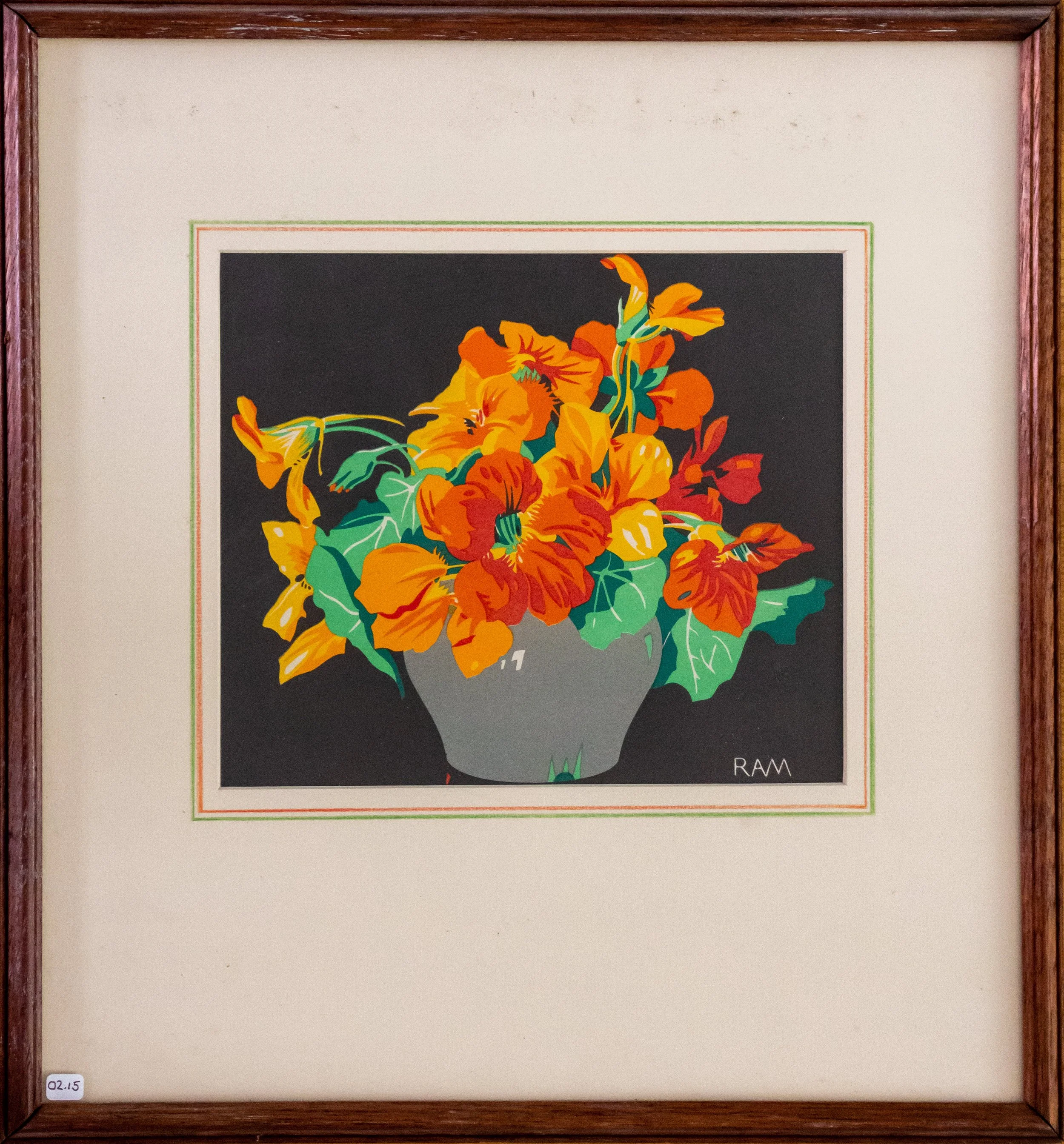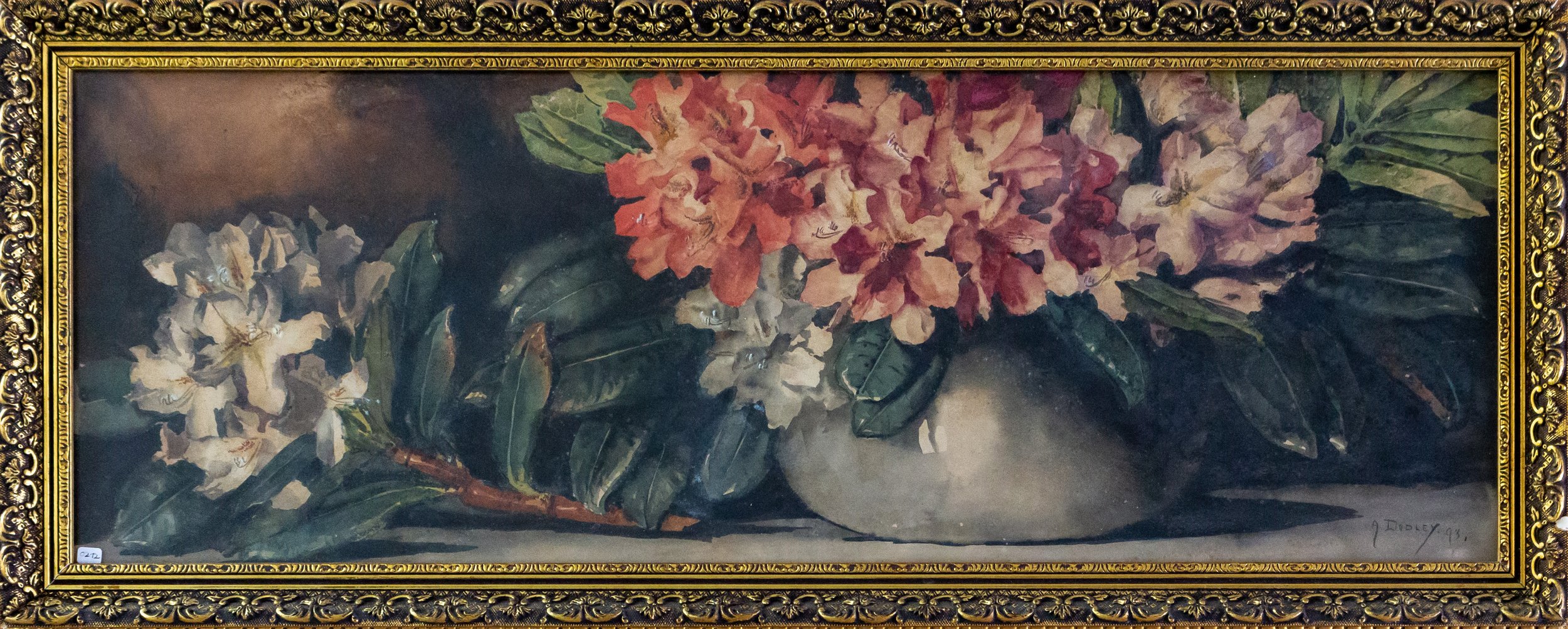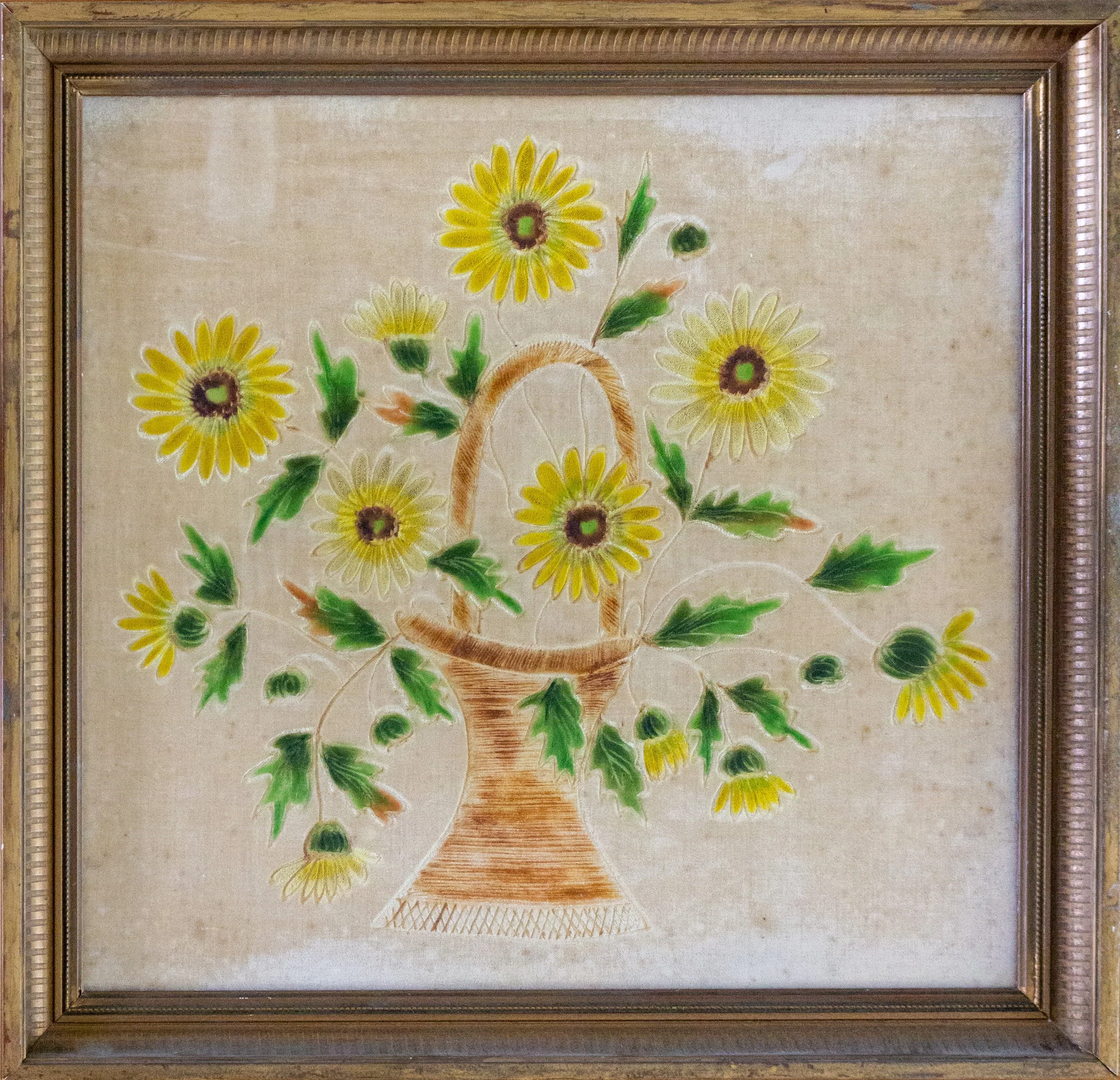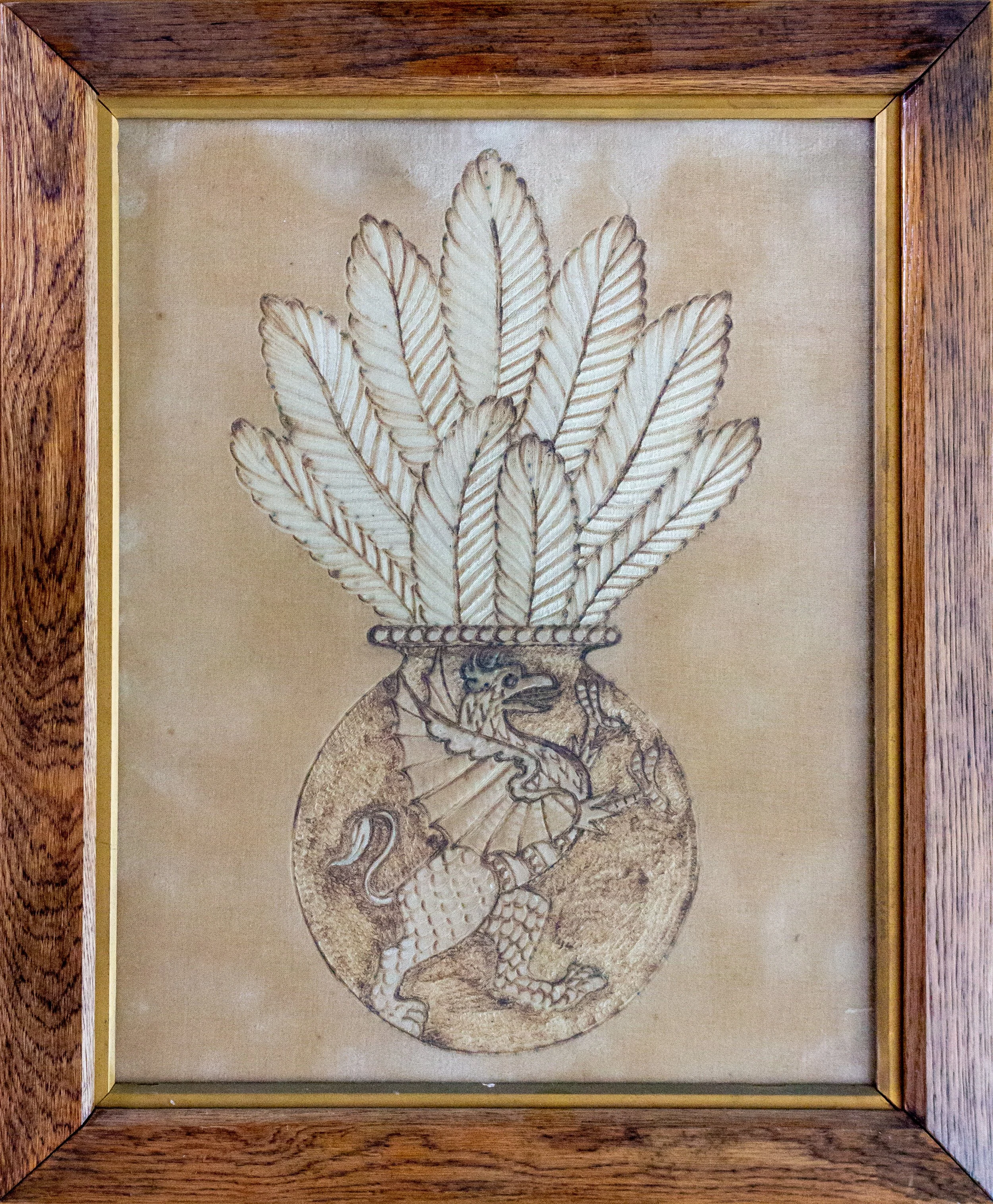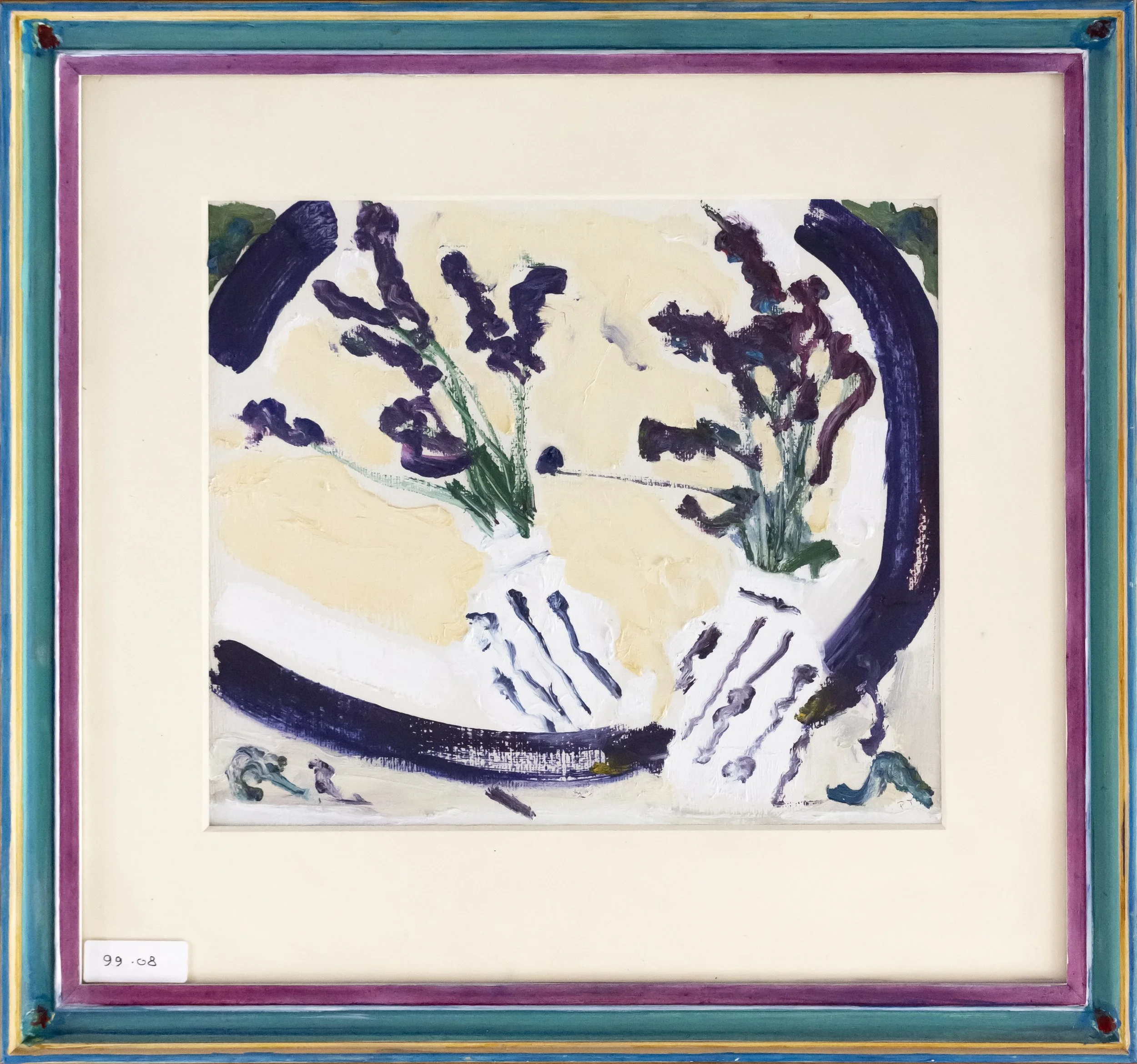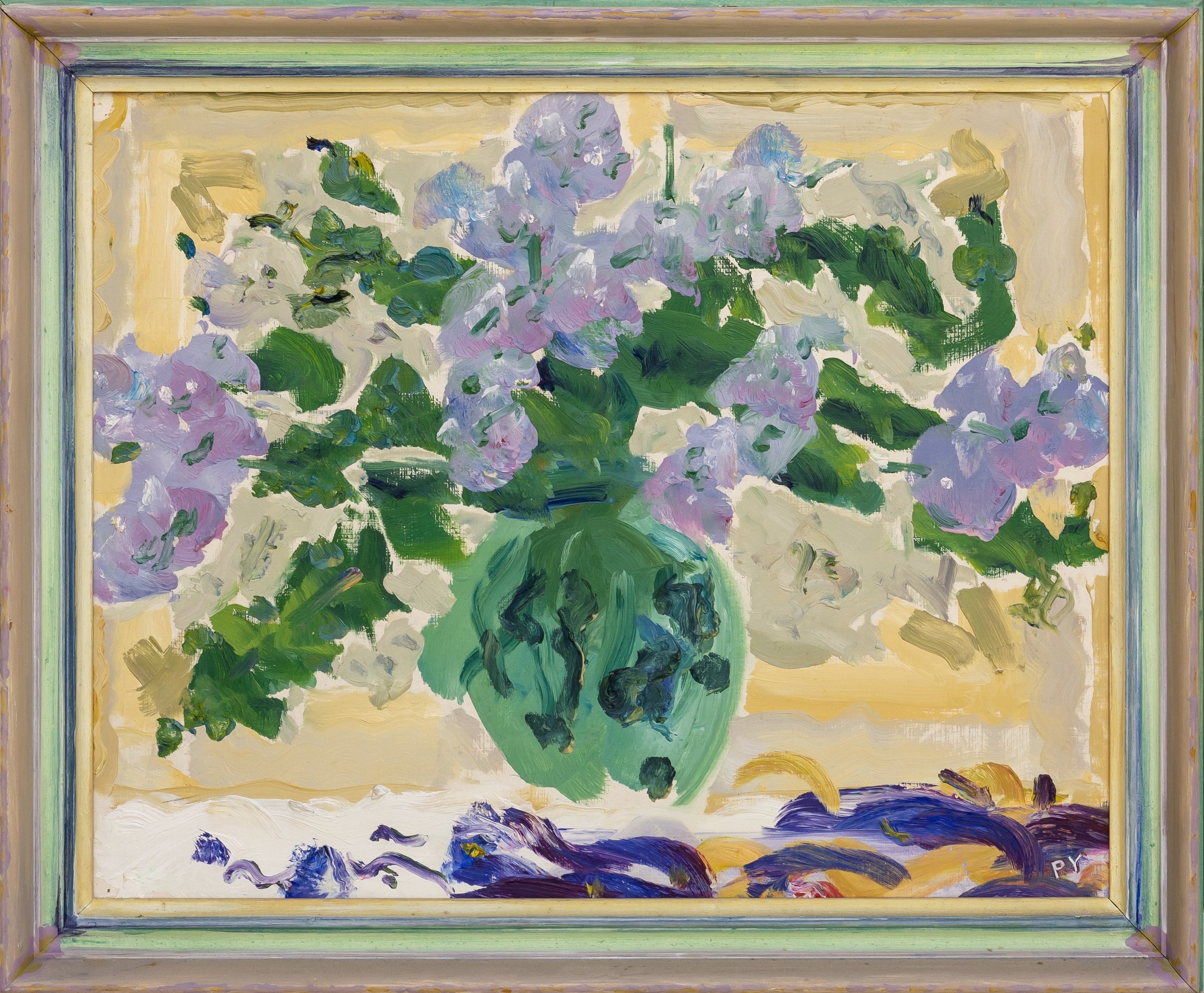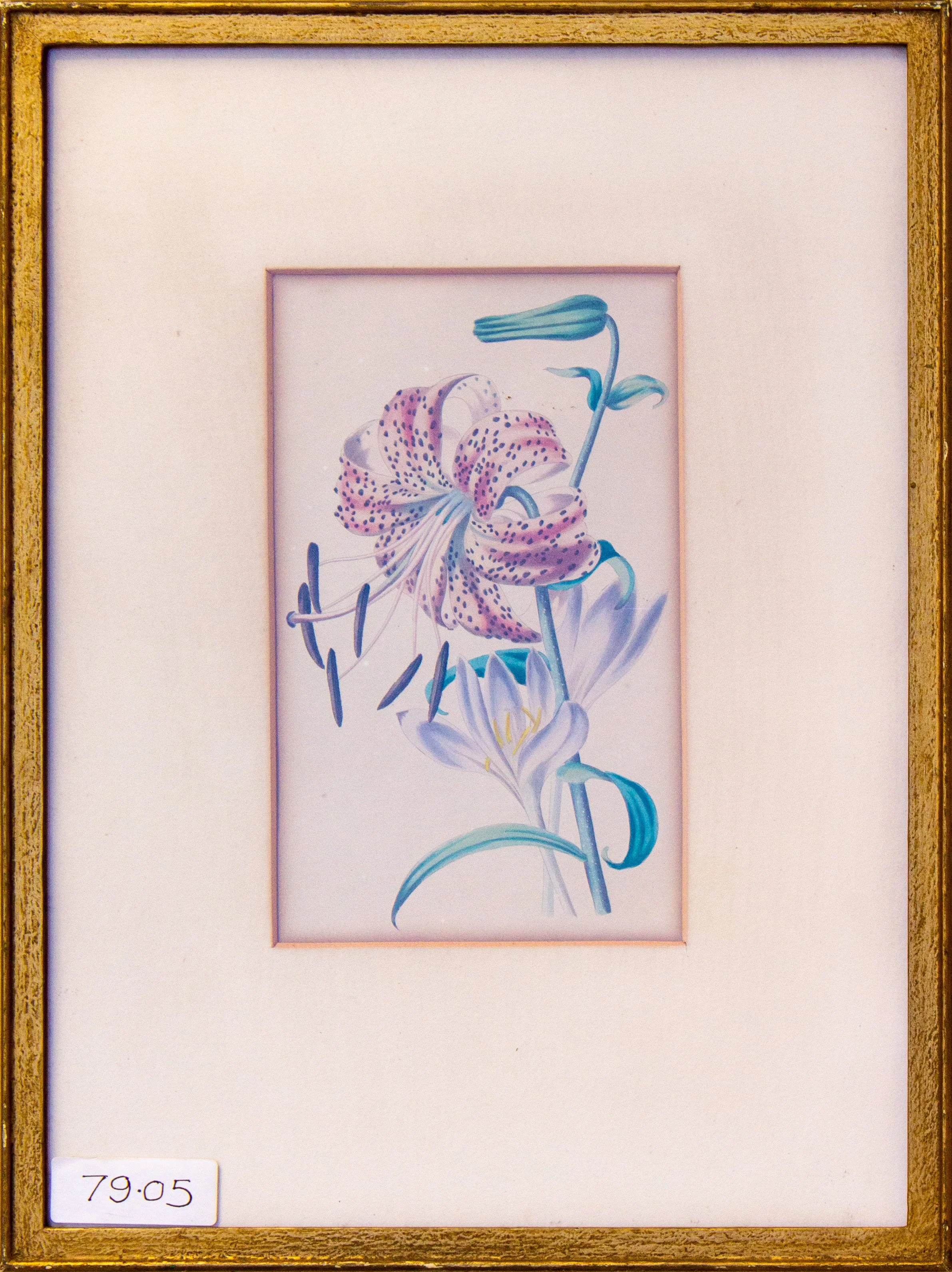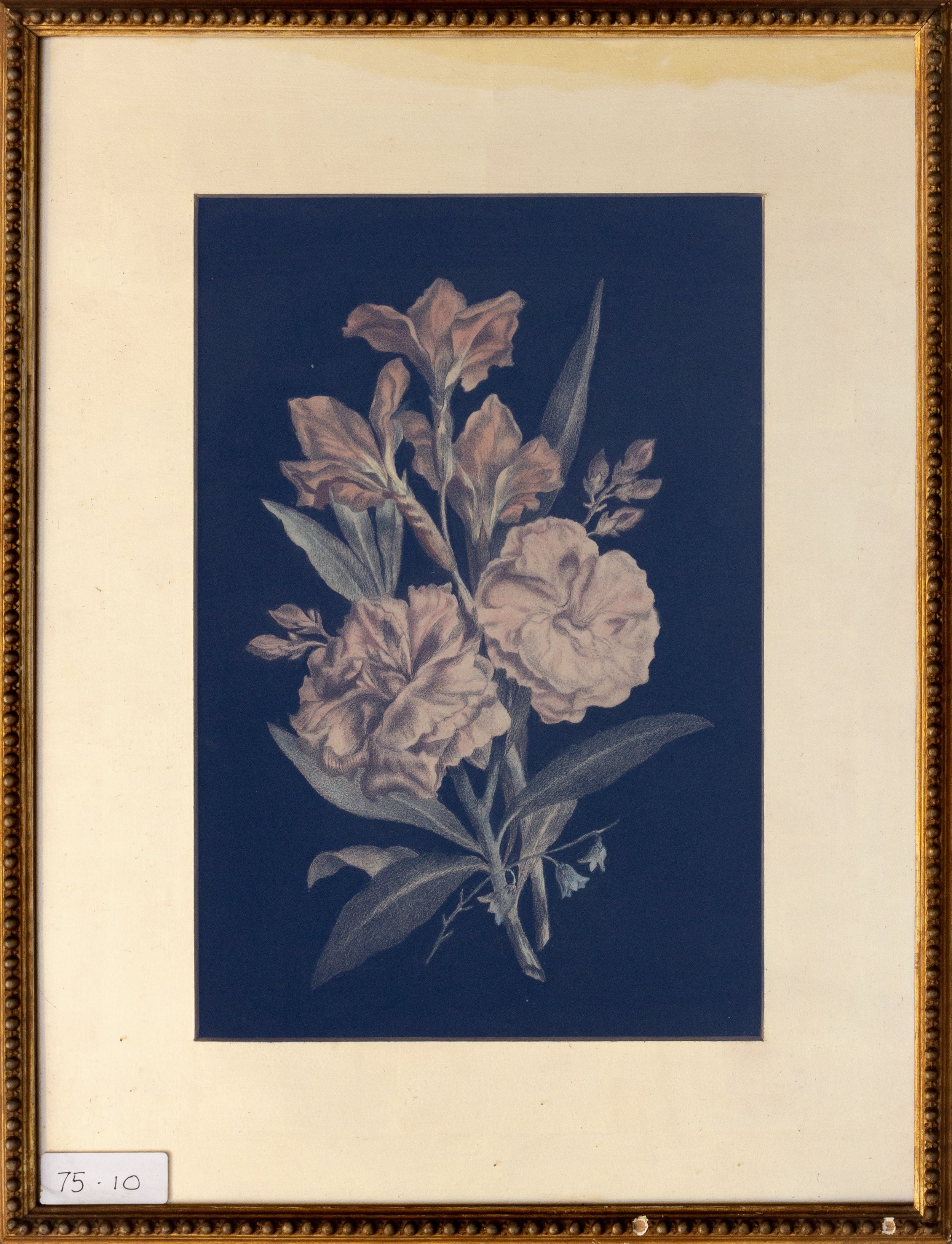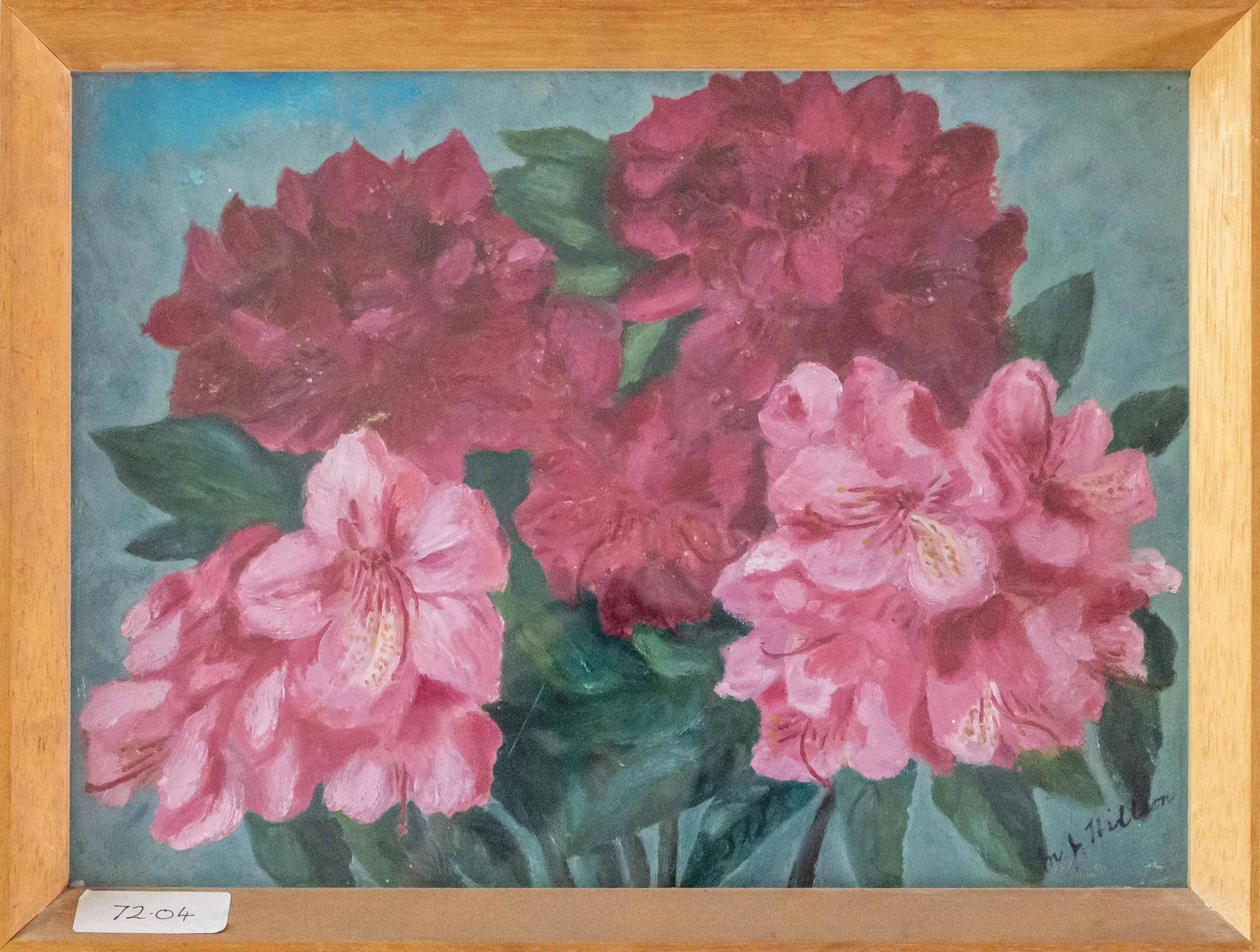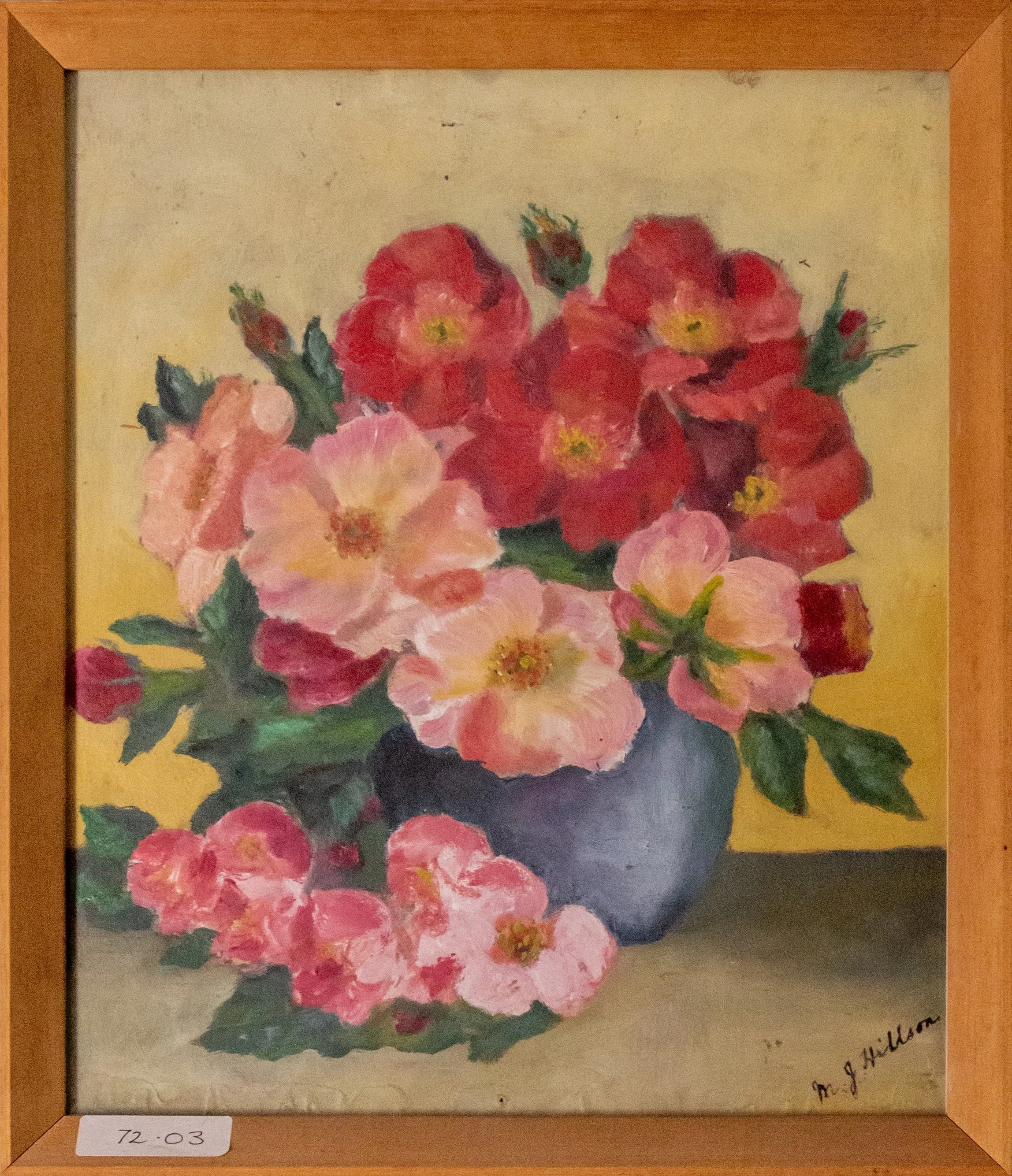02.46 Peace Lily
English
A linocut print using ink on paper by English artist Marcus Gohar (1960 - ) dating from the late twentieth century. Signed and framed. 30 cm high by 30 cm wide.
Marcus Gohar was born in West London and went to school at Chiswick Comprehensive school. He gained a Fine Arts degree at Kingston Polytechnic in 1983. He had a distinguished sporting career as a canoeistat international level and is now an equally distinguished coach. As an artist specialising in painting and printmaking, he has exhibited widely. He teaches English as a foreign language (EFL) at Oxford House College in Richmond. We acquired this nice example of his work from Julie Collino in January 2002.
Spanish
El lirio de la paz
Impresión en linograbado con tinta sobre papel del artista inglés Marcus Gohar (1960 -) que data de finales del siglo XX. Firmado y enmarcado. Mide 30 cm de alto por 30 cm de ancho.
Marcus Gohar nació en el oeste de Londres y fue al colegio en la Chiswick Comprehensive School. Se licenció en Bellas Artes en el Politécnico de Kingston, en 1983. Tuvo una distinguida carrera deportiva como piragüista a nivel internacional y ahora es un entrenador igualmente distinguido. Como artista especializado en pintura y grabado, ha expuesto ampliamente. Enseña inglés como lengua extranjera (EFL) en Oxford House College en Richmond. Adquirimos este bonito ejemplo de su trabajo a Julie Collino en enero de 2002.
02.32 Mulberry House Gardens
English
A watercolour painting by British artist Dorothy Davies dating from the mid twentieth century. Signed and framed. 24 cm high by 34 cm wide.
Written on the back are the words ‘Mulberry House garden’. This possibly refers to a well-known eighteenth century rectory with extensive gardens (now a hotel and wedding venue) in the east London borough of Ongar. We acquired this picture from Julie Collino in the closing down sale of her gallery in March 2002.
Spanish
Los jardines de la casa de las moras
Una acuarela de la artista británica Dorothy Davies, que data de mediados del siglo XX. Firmada y enmarcada. Mide 24 cm de alto por 34 cm de ancho.
En la parte posterior están escritas las palabras "Mulberry House garden". Esto posiblemente se refiere a una conocida rectoría del siglo XVIII con amplios jardines (ahora hotel y lugar de celebración de bodas) en el distrito de Ongar, al este de Londres. Adquirimos esta obra a través de Julie Collino, en la venta por liquidación de su galería en marzo de 2002.
02.30 Flowers
English
A small painting in oils on canvas by a Polish artist Wojciech Rucinski. Signed and date 1971. Framed. 20 cm high by 25 cm wide.
Neither Jane or I were very good at remembering each other’s birthdays, but since we were regularly buying artworks, we solved the problem by assigning the next object that we bought as the gift for the unremembered birthday. Thus this little picture, bought from Julie Collino on the 9th January 2002 came two days late to be my birthday present for that year. I have been unable to trace the artist, but his name appears on the reverse of the painting together with an address in England – 2, Oak Lodge, Oak Lane, London N11.
Spanish
Flores
Una pequeña pintura al óleo sobre lienzo del artista polaco Wojciech Rucinski. Firmado y fechado, 1971. Está enmarcado y mide 20 cm de alto por 25 cm de ancho.
Ni Jane ni yo éramos muy buenos recordando los cumpleaños de los demás, pero como comprábamos obras de arte con regularidad, resolvimos el problema asignando el siguiente objeto que compráramos como regalo para el cumpleaños no recordado. Así, este pequeño cuadro, adquirido a Julie Collino el 9 de enero de 2002, llegó dos días tarde para ser mi regalo de cumpleaños de ese año. No he podido localizar al artista, pero su nombre aparece en el reverso de la pintura junto con una dirección en Inglaterra: 2, OakLodge, Oak Lane, Londres N11.
02.26 Mauve Fuschia
English
A watercolour using gouache on paper by Briish artist Dorothy Bovey (1923 – 2003). Signed and framed, 29 cm high by 39 cm wide.
There is a detailed biography of botanical artist and adventurer Dorothy Bovey on this website.
She was a self-taught artist who took op painting in 1961 at the age of 38. By the mid-1970's she was the botanical artist on trips organized by the Scientific Exploration Society to Africa, the Middle East, and the Far East. This picture executed in a fine and methodically painted floral style is a good example of her work. Bought from Julie Collino in March 2002.
Spanish
Fucsia malva
Una acuarela en gouache sobre papel de la artista británica Dorothy Bovey (1923 - 2003). Firmada y enmarcada. Mide 29 cm de alto por 39 cm de ancho.
Hay una biografía detallada de la artista botánica y aventurera Dorothy Bovey en esta página web.
Fue una artista autodidacta que empezó a pintar en 1961 a la edad de 38 años. A mediados de los 70 fue la artista botánica en los viajes organizados por la Sociedad de Exploración Científica a África, Oriente Medio y el Lejano Oriente. Este cuadro ejecutado en un estilo floral fino y metódicamente pintado es un buen ejemplo de su trabajo. Lo compramos a Julie Collino en marzo de 2002.
02.18 Camelias
English
A painting using oils on board by Welsh artist Winifred Clement Smith (1904 - 2000). Signed on the back, in a gilt frame. 29 cm high by 34 cm wide.
Winifred Clement Smith was a painter and embroiderer who lived and worked in Tunbridge Wells. She studied at the Tunbridge Wells School of Art and later in London at the Regent Street Polytechnic School of Art. This elegant little picture was bought from Julie Collino in March 2002.
Spanish
Camelias
Una pintura al óleo sobre tabla de la artista galesa Winifred Clement Smith (1904 - 2000). Firmado al dorso, en un marco dorado. Mide 29 cm de alto por 34 cm de ancho.
Winifred Clement Smith fue una pintora y bordadora que vivió y trabajó en Tunbridge Wells. Estudió en la Tunbridge Wells School of Art y más tarde en Londres, en la Regent Street Polytechnic School of Art. Este cuadro pequeño y elegante fue comprado a Julie Collino en marzo de 2002.
02.15 Nasturtiums
English
A woodcut print by British artist Robert Ashwin Maynard (1888 – 1966) dating from the 1940"s/50"s. Signed/initialled RAM. Framed. 19 cm high by 32 cm wide.
Robert Maynard was a wood-cut printmaker, typographer, designer, painter and publisher. He was born in London where he studied at Westminster and the Central Schools of Art 1921-24. He then worked for the Davies sisters at Gregynog, Wales, and until 1930, was controller and director of the Gregynog Press and contributed illustrations for publications including: Henry Vaughan"s "Poems" and Milton"s "Samson Agonistes". With Walter Horace Bray he ran the Raven Press at Harrow Weald during the 1930s. Latterly he worked with other publishers. He exhibited with the London Group, the Arts and Crafts Exhibition Society and the Cooling Galleries. His work is held by Aberystwyth University, the Sterling Library - University of London, as well as by the British Museum.
Spanish
Capuchinas
Un grabado en madera del artista británico Robert Ashwin Maynard (1888 - 1966) que data de los años cuarenta y cincuenta. Firmada con las iniciales, RAM. Enmarcado. Mide 19 cm de alto por 32 cm de ancho.
Robert Maynard fue un grabador de madera, tipógrafo, diseñador, pintor y editor. Nació en Londres, donde estudió en Westminster y en las Escuelas Centrales de Arte, entre 1921 y 1924. Luego trabajó para las hermanas Davies en Gregynog, Gales, y hasta 1930 fue interventor y director de “Gregynog Press” y contribuyó con ilustraciones para publicaciones como "Poems", de Henry Vaughan y "SamsonAgonistes", de Milton. Con Walter Horace Bray dirigió “Raven Press”, en Harrow Weald, durante la década de 1930. En sus últimos años trabajó con otras editoriales. Expuso con el “London Group”, la “Arts and Crafts Exhibition Society” y las “Cooling Galleries”. Su obra está presente en la Universidad de Aberystwyth, la Biblioteca Sterling - Universidad de Londres, así como en el Museo Británico.
02.12 Flores
English
A watercolour on paper by British artist Arthur Dudley (1864 – 1919). Signed and dated (18)93, in a gilt frame. 28 cm high by 77 cm wide.
The plant recognition app on my ‘phone identifies these flowers as Canna lilies. Arthur Dudley RBA was a London-based painter, mainly using watercolours, of still life, fruit, flowers and fish. He also painted under the pseudonym Giovanni Barbaro. He was a member of the Royal Society of British Artists, where he exhibited as well as at the Royal Academy and the Walker Art Gallery in Liverpool. This picture came from Julie Collino in March 2002.
Spanish
Flores
Una acuarela sobre papel del artista británico Arthur Dudley (1864 - 1919). Firmada y fechada (18)93, en un marco dorado. Mide 28 cm de alto por 77 cm de ancho.
La aplicación de reconocimiento de plantas en mi teléfono identifica estas flores como lirios Canna. Arthur Dudley RBA fue un pintor afincado en Londres que utilizaba principalmente acuarelas, bodegones, frutas, flores y peces. También pintó bajo el seudónimo de Giovanni Barbaro. Fue miembro de la Royal Society of British Artists, donde expuso, así como en la Royal Academy y la Walker Art Gallery de Liverpool. Esta pintura proviene de Julie Collino en marzo de 2002.
01.08 Sunflowers
English
A theorem painting using watercolour on velvet by an unknown artist, dating from the late nineteenth century. Unsigned. Framed. 41 cm high by 38 cm wide.
This is the second theorem painting bought from Julie Collino in November 2001. See also 01.07 - Feathers. They were often painted on velvet, which was much denser than today's velvet cloth, in order togive the painting a softness in appearance. Thick watercolors were used. Theorems were also done on paper, cotton, and other cloth. The final product was usually finished off with hand painting of details like grapevines, or stems. Is it a coincidence that Van Gogh painted his Sunflowers in the 1880’s?
Spanish
Girasoles
Una pintura de teoremas con acuarela sobre terciopelo, de autor desconocido, que data de finales del siglo XIX. Está sin firmar y enmarcada. Mide 41 cm de alto por 38 cm de ancho.
Esta es la segunda pintura de teoremas comprada a Julie Collino en noviembre de 2001. Ver también 01.07 - Plumas. A menudo se pintaban sobre terciopelo, que era mucho más denso que la tela de terciopelo actual, para darle a la pintura una apariencia suave. Se utilizaron acuarelas gruesas. También se hacían teoremas en papel, algodón y otras telas. El producto final generalmente se remataba con detalles de vides o tallos, realizados a mano. ¿Es una coincidencia que Van Gogh pintara sus Girasoles en la década de 1880?
01.07 Feathers
English
A ‘theorem’ painting, ninteenth century, by an unknown (North American?) artist using stencil painting on velvet. 48 cm high by 37 cm wide.
This picture of feathers in a dragon decorated jar came from Julie Collino (see 87.04) in November 2001.Theorem stencil, sometimes also called theorem painting or velvet painting, is the art of making stencils and using them to make drawings or paintings on fabric or paper. A vogue for theorem stencil painting began in England at the turn of the 18th century and through the mid-1800s. The art was extensively taught to young women in academies and boarding schools throughout ex-colonial New England into the late nineteenth century and in many other places. The designs are traditionally painted on velvet. The stencils are multiple overlays and designs are always three-dimensional, primitive and stylized in nature. It was often referred to colloquially as "Poonah painting", because of its supposed origin in the Indian city of Pune.
Spanish
Plumas
Una pintura de 'teorema', del siglo XIX, de un artista desconocido/a (¿norteamericano/a?) que usa pintura de stencil sobre terciopelo. Mide 48 cm de alto por 37 cm de ancho.
Esta imagen de plumas en un frasco decorado con un dragón la obtuvimos a través de Julie Collino (ver 87.04) en noviembre de 2001. La plantilla de teoremas, a veces también llamada pintura de teoremas o pintura de terciopelo, es el arte de hacer plantillas y usarlas para hacer dibujos o pinturas sobre tela o papel. La moda de la pintura con plantillas de teoremas comenzó en Inglaterra a principios del siglo XVIII hasta mediados del siglo XIX. Este arte se enseñó extensamente a mujeres jóvenes en academias e internados en toda la ex-colonia de Nueva Inglaterra hasta finales del siglo XIX y en muchos otros lugares. Los diseños se pintan tradicionalmente sobre terciopelo. Las plantillas son superposiciones múltiples y los diseños son siempre tridimensionales, primitivos y de naturaleza estilizada. A menudo se la denomina coloquialmente como "pintura de Poonah", debido a su supuesto origen en la ciudad india de Pune.
99.08 Lavender in crystal vase – reflected image
English
Three paintings by Peter Young
Catalogue number 99.08 ‘Lavender in crystal vase – reflected image’, oils on board, framed and initialed, 30 cm. high by 36 cm. wide. Bought from the artist in June 1999 at an exhibition organized by the Friends of Imperial College.
Peter Young was a colleague of Jane’s in the Conservation Department at the Victoria and Albert Museum, and a very distinguished Head of the Paintings Conservation unit there.
He had always painted, but when he retired in 1993 he was able to devote more time to it, and increasingly turned towards painting still life and flower subjects. In his own words:- ‘My painting of flowers exhibit a spontaneity that is in complete contrast to the exacting technique of my professional life. I revel in the freedom of painting, and I hope the pictures move with an inner life which draws the viewer into a celebration of the natural world.’
Spanish
Tres pinturas de Peter Young
Número de catálogo 99.08 "Lavanda en florero de cristal - imagen reflejada", óleo sobre tablero, enmarcado y rubricado, 30 cm de alto por 36 cm de ancho. Comprado al artista en junio de 1999 en una exposición organizada por el Friends of Imperial College.
Peter Young era un colega de Jane en el Departamento de Conservación del Museo Victoria and Albert y un muy distinguido Jefe de la Unidad de Conservación de Pinturas allí.
Siempre había pintado, pero cuando se retiró en 1993 pudo dedicarle más tiempo y se dedicó cada vez más a pintar bodegones y flores. En sus propias palabras: “Mi pintura de flores exhibe una espontaneidad que está en completo contraste con la técnica exigente de mi vida profesional. Me deleito en la libertad de pintar, y espero que las imágenes se muevan con una vida interior que atraiga al espectador a una celebración del mundo natural ".
96.04 Red tulips in crystal vase
English
Three paintings by Peter Young
Catalogue number 96.04 ‘Red Tulips in a crystal vase’, oils on board, framed and initialed, 48 cm. high by 33 cm. wide. Bought from the artist in October 1996, following an exhibition at Patisserie Valerie in Brompton Road in London.
Peter Young was a colleague of Jane’s in the Conservation Department at the Victoria and Albert Museum, and a very distinguished Head of the Paintings Conservation unit there.
He had always painted, but when he retired in 1993 he was able to devote more time to it, and increasingly turned towards painting still life and flower subjects. In his own words:- ‘My painting of flowers exhibit a spontaneity that is in complete contrast to the exacting technique of my professional life. I revel in the freedom of painting, and I hope the pictures move with an inner life which draws the viewer into a celebration of the natural world.’
Spanish
Tres pinturas de Peter Young
Número de catálogo 96.04 "Tulipanes rojos en un jarrón de cristal", óleo sobre tablero, enmarcado y rubricado, 48 cm de alto por 33 cm de ancho. Comprado al artista en octubre de 1996, después de una exposición en Patisserie Valerie en Brompton Road, Londres.
Peter Young era un colega de Jane en el Departamento de Conservación del Museo Victoria and Albert y un muy distinguido Jefe de la Unidad de Conservación de Pinturas allí.
Siempre había pintado, pero cuando se retiró en 1993 pudo dedicarle más tiempo y se dedicó cada vez más a pintar bodegones y flores. En sus propias palabras: “Mi pintura de flores exhibe una espontaneidad que está en completo contraste con la técnica exigente de mi vida profesional. Me deleito en la libertad de pintar, y espero que las imágenes se muevan con una vida interior que atraiga al espectador a una celebración del mundo natural ".
94.08 Blue Lilac in green ceramic vase
English
Three paintings by Peter Young
Catalogue number 94.08 ‘Blue Lilacs in green ceramic vase’, oils on linen, framed and initialed, 40 cm. high by 50 cm wide, bought from Clarges Gallery in Walton Street, London in June 1994.
Peter Young was a colleague of Jane’s in the Conservation Department at the Victoria and Albert Museum, and a very distinguished Head of the Paintings Conservation unit there.
He had always painted, but when he retired in 1993 he was able to devote more time to it, and increasingly turned towards painting still life and flower subjects. In his own words:- ‘My painting of flowers exhibit a spontaneity that is in complete contrast to the exacting technique of my professional life. I revel in the freedom of painting, and I hope the pictures move with an inner life which draws the viewer into a celebration of the natural world.’
Spanish
Tres pinturas de Peter Young
Número de catálogo 94.08 "Lilas azules en un jarrón de cerámica verde", óleo sobre lino, enmarcado y rubricado, 40 cm alto por 50 cm de ancho, comprado en Clarges Gallery en Walton Street, Londres en junio de 1994.
Peter Young era un colega de Jane en el Departamento de Conservación del Museo Victoria and Albert y un muy distinguido Jefe de la Unidad de Conservación de Pinturas allí.
Siempre había pintado, pero cuando se retiró en 1993 pudo dedicarle más tiempo y se dedicó cada vez más a pintar bodegones y flores. En sus propias palabras: “Mi pintura de flores exhibe una espontaneidad que está en completo contraste con la técnica exigente de mi vida profesional. Me deleito en la libertad de pintar, y espero que las imágenes se muevan con una vida interior que atraiga al espectador a una celebración del mundo natural ".
79.05 Tiger lily
English
By an unknown artist, watercolour on paper, 12 cm. wide by 20 cm. high. Framed.
We bought this small watercolour from the ‘flea market’ in Camden Passage in Islington, North London one Saturday morning in 1979. For those who do not know it, Camden Passage is home to antique and ‘collectable’ shops of all shapes and sizes, and goods of all shapes and sizes too. In those days, and I think that it is the same today, Wednesday and Saturday mornings were ‘bargain hunting’ days with the shop owners setting up stalls in the street.
This is in the botanical drawing tradition – a Lilium Lanciforum in full bloom and two Crocus Sativus. On the back of the drawing is a name and address – Miss Impey, 37, Golden Square, Soho – presumably its owner when it was framed. She would no doubt be astonished to know that the house she lived in some one hundred years earlier was sold for re-development in 2018 for 43 million pounds!
Spanish
Tiger Lily, de autor desconocido. Acuarela sobre papel, enmarcada, mide 12 cm de ancho por 20 cm de alto. Nº de catálogo 79.05.
“Compramos esta pequeña acuarela en el “mercado de las pulgas” de Camden Passage, en Islington, al norte de Londres, un sábado por la mañana de 1979. Para quienes no lo sepan, Camden Passage es el hogar de tiendas antiguas y de "colección" de todo tipo y tamaño, con objetos de todo tipo y tamaño, también. En aquel tiempo, y creo que sucede lo mismo en la actualidad, los miércoles y los sábados por la mañana eran días de "caza de gangas", con los dueños de las tiendas montando sus puestos en la calle.
Esta pieza sigue la tradición del dibujo botánico: un Lilium Lanciforum en plena floración y dos Crocus Sativus. En la parte posterior del dibujo hay un nombre y una dirección: Miss Impey, Golden Square, 37 - Soho, presumiblemente los datos de su propietaria cuando se enmarcó. Sin duda se sorprendería al saber que la casa en la que vivía unos cien años antes se vendió en 2018 ¡por 43 millones de libras!”.
78.02 Folding screen
English
English made, circa 1870. Each of four panels 58 cm wide by 170 cm high.
Large draughty homes and often large families meant that screens (or folding room dividers) were an ever-present feature in the Victorian household. This four-panel folding screen is finely made with polished oak frames, brass two-way hinges and castors. The fabric coverings are modern.
It was purchased from Windsor House Antiques, Lillie Road in Fulham, London (at the western end of Lillee Road, there is a group of wonderful specialist antique shops) for the purpose for which it was designed, to divide our bedroom and to provide space for our newly-born daughter’s cot.
Spanish
Biombo
Fabricado en Inglaterra en 1870, aproximadamente. Cada panel mide 58 cm de ancho por 170 cm de alto.
“Las grandes casas abiertas a corrientes de aire y a menudo habitadas por familias numerosas, significaban que los biombos (o las mamparas plegables) fueran una característica siempre presente en los hogares Victorianos. Este biombo de cuatro paneles plegables está finamente elaborado con marcos de roble pulido, bisagras de dos vías de latón y ruedas. Los revestimientos de tela son modernos.
Fue comprado en “Windsor House Antiques”, de Lillie Road en Fulham, Londres (en el extremo oeste de Lillee Road, hay un grupo de maravillosas tiendas de antigüedades especializadas) para el propósito para el cual fue diseñado: dividir nuestra habitación y proporcionar espacio para la cuna de nuestra hija recién nacida.
75.10 Botanical drawing
English
A botanical drawing by an unknown artist using coloured crayons on black paper from the end of the 19thcentury. Framed. 22 cm wide by 33 cm high.
The 19th century was a period of great interest in the natural world, and a time of intensive activity identifying, collecting and codifying species of plants, animals and insects. This led to a worldwide emergence of ranks of botanists, gardeners and natural historians, and alongside them, the botanical illustrator flourished, of whom the best known from Britain from that period are probably William Jackson Hooke, Anne Pratt, Walter Hood Finch and Marianne North. The skill of the botanical illustrator is to be able to create a compromise of accuracy, an idealized image from several specimens and the inclusion of face and reverse of the features such as petals and leaves. This example, bought from the Warwick Antique Centre in 1975 can be accurately dated by its frame (made by John H Paris, 15 and 17 Leece Street, Liverpool) to 1885. The two larger flowers (according to a ‘plant identifier’ app.!) are Mathiola Incana, and the others in the bunch are Nerium Oleander. I await correction by those more knowledgeable than me. The sprig at the bottom is harebell.
Spanish
Dibujo botánico, de autor desconocido, elaborado con lápices de colores sobre papel negro a finales del siglo XIX. Está enmarcado y mide 22 cm de ancho por 33 cm. Nº de catálogo 75.10.
“El siglo XIX fue un período de gran interés por el mundo natural, y una época de intensa actividad de identificación, recolección y codificación de especies de plantas, animales e insectos. Todo ello favoreció la proliferación mundial de un gran número de botánicos, jardineros e historiadores naturales, y junto a ellos floreció el ilustrador botánico, de los cuales los más conocidos en Gran Bretaña en ese período sean probablemente William Jackson Hooke, Anne Pratt, Walter Hood Finch y Marianne North.
La habilidad del ilustrador botánico es ser capaz de crear un compromiso de precisión, una imagen idealizada de varios especímenes y la inclusión del anverso y el reverso de características tales como pétalos y hojas. Este ejemplo, comprado en el Warwick Antique Centre en 1975, se puede fechar con precisión por su marco (hecho por John H. Paris, Leece Street 15 y 17, Liverpool) hacia 1885. Las dos flores más grandes (según información obtenida a través de una app identificadora de plantas!) son Mathiola Incana, y los otros en el grupo son Nerium Oleander.
Espero la corrección de aquellos más conocedores que yo. La ramita en la parte inferior es campanilla”.
72.05 Daffodils
English
Mabel J Hillson lived and worked in Leamington Spa, and was 85 years old when we met her in 1972. (She lived on to the great age of 99). She was well known locally as a painter of still-life works, examples of which can be seen at the Leamington Art Gallery.
She was about to throw these three paintings away - she said that she had painted them in the 1950’s when experimenting with hardboard as a substitute for canvas, that they were unfinished and unsatisfactory. So, rather than her disposing of them, we bought them from her for a nominal amount.
Maybe she was right, and perhaps they are rather ordinary, but we happily hung them, albeit in the guest bedroom, of our first home.
Spanish
Tres pinturas de Mabel J Hillson (1887-1986). Se trata de tres óleos sobre tablero, firmados y enmarcados.
'Narcisos' - 40cm. de ancho por 50cm de alto.
Mabel J Hillson vivió y trabajó en Leamington Spa, y tenia 85 años cuando la conocimos en 1972 (vivió hasta los 99 años). Ella era reconocida localmente como pintora de naturalezas muertas, que pueden contemplarse actualmente en la Leamington Art Gallery.
Estaba a punto de tirar estas tres pinturas - nos dijo que las había pintado en los años 50, cuando experimentaba con el tablero como un sustituto del lienzo, y que para ella estaban inacabadas y resultaban insatisfactorias. Y por eso, antes de que se deshiciera de ellas, las compramos por una cantidad muy razonable.
Tal vez tenia razón, y quizás son bastante ordinarias, pero felizmente las colgamos, aunque en el dormitorio de invitados, de nuestro primer hogar.
72.04 Pink Flowers 2
English
Mabel J Hillson lived and worked in Leamington Spa, and was 85 years old when we met her in 1972. (She lived on to the great age of 99). She was well known locally as a painter of still-life works, examples of which can be seen at the Leamington Art Gallery.
She was about to throw these three paintings away - she said that she had painted them in the 1950’s when experimenting with hardboard as a substitute for canvas, that they were unfinished and unsatisfactory. So, rather than her disposing of them, we bought them from her for a nominal amount.
Maybe she was right, and perhaps they are rather ordinary, but we happily hung them, albeit in the guest bedroom, of our first home.
Spanish
Tres pinturas de Mabel J Hillson (1887-1986). Se trata de tres óleos sobre tablero, firmados y enmarcados.
'Flores rosadas 2' - 39cm. de ancho por 27cm. de alto.
Mabel J Hillson vivió y trabajó en Leamington Spa, y tenia 85 años cuando la conocimos en 1972 (vivió hasta los 99 años). Ella era reconocida localmente como pintora de naturalezas muertas, que pueden contemplarse actualmente en la Leamington Art Gallery.
Estaba a punto de tirar estas tres pinturas - nos dijo que las había pintado en los años 50, cuando experimentaba con el tablero como un sustituto del lienzo, y que para ella estaban inacabadas y resultaban insatisfactorias. Y por eso, antes de que se deshiciera de ellas, las compramos por una cantidad muy razonable.
Tal vez tenia razón, y quizás son bastante ordinarias, pero felizmente las colgamos, aunque en el dormitorio de invitados, de nuestro primer hogar.
72.03 Pink Flowers 1
English
Mabel J Hillson lived and worked in Leamington Spa, and was 85 years old when we met her in 1972. (She lived on to the great age of 99). She was well known locally as a painter of still-life works, examples of which can be seen at the Leamington Art Gallery.
She was about to throw these three paintings away - she said that she had painted them in the 1950’s when experimenting with hardboard as a substitute for canvas, that they were unfinished and unsatisfactory. So, rather than her disposing of them, we bought them from her for a nominal amount.
Maybe she was right, and perhaps they are rather ordinary, but we happily hung them, albeit in the guest bedroom, of our first home.
Spanish
Tres pinturas de Mabel J Hillson (1887-1986). Se trata de tres óleos sobre tablero, firmados y enmarcados.
'Flores rosadas 1' - 29cm. de ancho por 34cm. de alto.
Mabel J Hillson vivió y trabajó en Leamington Spa, y tenia 85 años cuando la conocimos en 1972 (vivió hasta los 99 años). Ella era reconocida localmente como pintora de naturalezas muertas, que pueden contemplarse actualmente en la Leamington Art Gallery.
Estaba a punto de tirar estas tres pinturas - nos dijo que las había pintado en los años 50, cuando experimentaba con el tablero como un sustituto del lienzo, y que para ella estaban inacabadas y resultaban insatisfactorias. Y por eso, antes de que se deshiciera de ellas, las compramos por una cantidad muy razonable.
Tal vez tenia razón, y quizás son bastante ordinarias, pero felizmente las colgamos, aunque en el dormitorio de invitados, de nuestro primer hogar.
